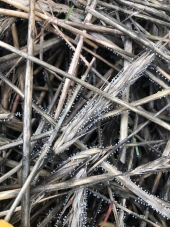The top one, especially, looks like some kind of fungus...
I see it now, especially the top one. If the 'spheres' are indented in one side, it could be one of the jelly mushrooms (like the family you find witches butter in). The more I look at it, the more the top one reminds me of baby witches butter, only I've ever seen it on logs not mulch.
Then again, this slime mold is interesting too. I'm off to learn more about it. Thanks for the link.









